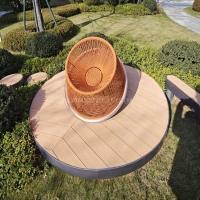Welcome to the website for landscape facilities products and knowledge.
What are the most effective ways to incorporate a built-in step or platform for outdoor educational or workshop activities?
Outdoor educational spaces have evolved beyond simple picnic tables and open fields. Incorporating built-in steps and platforms creates dynamic, multifunctional environments that enhance learning experiences while blending seamlessly with natural surroundings. These integrated structures provide practical solutions for seating, staging, and interactive learning while promoting accessibility and safety.
The most effective approach begins with strategic location selection. Position platforms in partially shaded areas with natural wind protection, preferably with interesting natural features like mature trees or rock formations as backdrops. The orientation should consider sun movement throughout the day, ensuring comfort during various workshop times.
Multilevel designs prove particularly effective for educational purposes. Tiered step structures naturally create amphitheater-style seating that facilitates clear visibility for demonstrations and presentations. These steps can double as additional workspace during hands-on activities, with the upper levels serving as demonstration platforms and lower levels providing seated workspace. The height variation creates natural learning zones without physical barriers.
Material selection significantly impacts functionality and sustainability. Natural stone offers permanence and blends beautifully with landscapes, while reclaimed wood provides warmth and environmental storytelling opportunities. Composite materials offer low maintenance solutions for permanent installations. Incorporate natural textures that complement the surroundings while providing practical surfaces for various educational activities.
Integrated storage solutions enhance functionality dramatically. Design riser steps with hinged lids for storing teaching materials, cushions, or workshop supplies. Side panels can conceal weather-proof storage compartments for larger items. This approach maintains the natural appearance while keeping essential materials conveniently accessible yet protected from the elements.
Accessibility integration remains crucial for inclusive educational spaces. Incorporate graduated ramp systems alongside stepped platforms, ensuring wheelchair access to multiple levels. Design platform surfaces with slight slopes for water drainage while maintaining accessibility standards. Railings can serve dual purposes as learning aids for plant identification or sensory experiences.
Flexible configuration options maximize utility. Create modular platform systems that can be rearranged for different group sizes and activities. Some sections might serve as presentation stages while others function as group work tables or individual observation stations. Mobile elements that lock into built-in foundations provide adaptability while maintaining permanent structure benefits.
Natural integration techniques help structures blend with the environment. Incorporate planting pockets within step risers for native ground covers that soften edges and create living learning opportunities. Use natural contours rather than leveling sites completely, working with existing topography to reduce construction impact and create more interesting spatial relationships.
Weather resilience considerations ensure year-round usability. Design platform surfaces with slight gaps for drainage and use materials that withstand freeze-thaw cycles. Incorporate slight backward slopes on seating surfaces to quickly shed rainwater. Overhead structures or nearby trees can provide partial protection while maintaining the open-air experience.
Educational enhancements transform structures into teaching tools. Embed measurement markers into platform edges for science activities, incorporate fossil or mineral specimens in poured concrete elements, or create seasonal sunlight markers that demonstrate astronomical concepts. These built-in features make learning opportunities ever-present rather than added later.
Lighting integration extends usability into evening hours. Solar-powered LED strips under step overhangs provide safe illumination without tripping hazards. Low-voltage lighting can highlight specific teaching areas while maintaining night vision for astronomical observations. Strategic lighting creates magical evening learning environments.
Successful implementations always consider the specific educational programs intended for the space. Nature centers might prioritize close-ground observation platforms, while art programs may need larger flat surfaces for projects. Always design with the primary users in mind while maintaining flexibility for unexpected uses. The most effective outdoor educational spaces feel both intentionally designed and naturally belonging to their environment.
Related search:

Recommendation
Swivel chair-Specialty steel structure woven rattan leisure chair with rotatable design